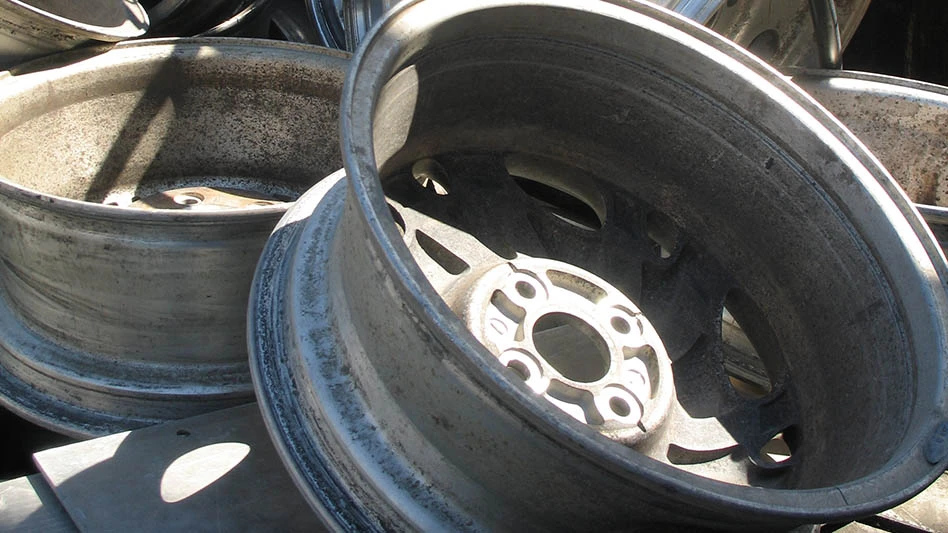So far, scrap trade across the Mexican and Canadian borders is basically business as usual.
As predicted by many in the scrap industry, the North American Free Trade Agreement is having little or no effect on the trading and movement of scrap commodities between Canada, Mexico and the United States. That’s because scrap is a raw material and not a finished product, so it was not subject to heavy tariffs in the first place. Also, the U.S. already had bilateral agreements on the movement of waste and scrap in place since 1986, so there have been few surprises there, either.
"I have heard some major concerns with the Basel Convention on its direct effect on scrap trade, but none for NAFTA," says Gerald Houck, iron and steel commodity specialist for the U.S. Bureau of Mines, Washington. According to Houck, 1991 iron and steel scrap shipments from the U.S. to Mexico were 673,000 metric tons and to Canada were 806,000 metric tons. In 1994, those shipments were 664,000 metric tons to Mexico (a slight decrease) and 1.68 million metric tons to Canada (a more than two-fold increase).
One scrap metal supplier says that he has not witnessed any "noticeable drop in scrap metal shipments to Mexico" and sees the slight decrease in shipments to that country as a result of "the transfer of mills from state to private ownership." As for Canada shipments, the strong scrap metal trade in that country is "purely due to that country’s solid economy" that has been growing ever since the recession of the late 1980s and early 1990s.
"NAFTA has not effected the trade of scrap material between the three countries," says Tom Wolfe, managing director of government relations for the Institute of Scrap Recycling Industries, Washington.
"It (scrap) is traded as a raw material and not a finished good," he continued, "so there were not, and still are not, any major restrictions on that trade. It basically was free trade before, and it is free trade today. The only problem that I am aware of is the transportation of batteries which are considered a hazardous waste in Canada and not in the U.S. So, the manifesting is different and there have been some delays at the border, but no significant problems."
"NAFTA has not had any noticeable affect on either side (Canadian/U.S.) concerning the paper industry," confirms Tom Bowers of the Eastern Paper Mills Suppliers Association, Boston, Mass. "The market has been strong and the scrap paper industry has been mirroring that strength. The only concern is (monetary) exchange rates."
And the numbers support that strong market. Scrap paper shipments from the U.S. to Canada were 1.18 million tons in 1993 and 1.75 million tons in 1994 (a 33 percent increase over 1993). Scrap paper shipments from the U.S. to Mexico were 700,000 tons in 1993, then rose to 1.12 million tons in 1994 (a 38 percent increase over 1993).
MEXICO CONCERNS
The major concern presently is the Mexican economy – an economy that unexpectedly "hiccupped" about seven months ago due to the sudden devaluation of the peso. It now will take longer than expected before that economy gains comparable strength to the U.S. and Canada economies. Thus, as the Mexican economy grows, more jobs will be created and personal income will increase; therefore, larger ticket items will become more affordable, such as cars and appliances.
Another area that could help Mexico is the agricultural market. As farm output increases, the need for capital investments such as tractors and harvesting equipment will increase. If more food stocks are produced, there will be a need for more canning, bottling and so on. All of this, in turn, means that there will be a need for more metal and scrap metal, cullet and paper as the engines of capitalism rev up.
"I think that the devaluation of the peso in Mexico has created more concern than NAFTA has," continues Wolfe. "Before, you had companies thinking about expanding into that country, now they have put their plans on hold because the economy is currently unstable. So, we have not seen the anticipated large-scale movement of companies south yet."
It does, however, appear that Mexico’s economic crisis is easing somewhat in the aftermath of the rapid devaluation of the peso which began last December. According to the Wall Street Journal, Mexico’s annual inflation rate eased to 67 percent, down from a high of 220 percent in April 1995 and foreign reserves rose by $200 million at the end of May 1995, "signaling that foreign money may be returning" to the country. That’s good news because it means that foreign investors are gaining confidence in Mexico’s ability to make a full economic recovery.
TRADE LAWS
NAFTA has also posed some concerns with existing trade laws. Recently, the American Iron and Steel Institute hosted a discussion in Washington on "North American Fair Trade in Steel Under NAFTA – A Symposium on Trade Laws and Steel Trade Under the North American Free Trade Agreement." Its purpose was to review the application of fair trade laws within the North American Free Trade Area to assess whether alternative approaches might be more appropriate for an increasingly integrated market. The event was attended by about 50 steel industry executives and government officials from all three NAFTA countries.
Although AISI does not want to comment on the "closed door" proceedings at this time, Fred Telmer, chairman of AISI’s North American Steel Council and who is also chairman of Stelco Inc., says that, "In discussing the NAFTA trade laws issue, we all agreed that our first order of business must continue to be to ensure that steel remains the material of choice in an ever widening number of market applications."
Another item that was addressed was anti-dumping duty laws as they apply to the NAFTA pact. Overall, the U.S. is not in favor of eliminating trade laws in lieu of NAFTA, but is working with the other two countries to address problems in trade regulations that may be cause for concern or conflict with NAFTA. The U.S. is also trying to streamline its own trade regulations in the process.
LEGITIMIZING BUSINESS
Preston Horne-Brine, managing director of business assistance and commodities with the Clean Washington Center, Seattle, Wash., has a more positive view of NAFTA and its effect on scrap trade and scrap-related industries. "I think NAFTA has had a positive affect on scrap trade and I think it will continue to help in the future," he says. "I have seen companies (especially paper mills) grow across boundary lines and a number of mergers and acquisitions that were encouraged by the NAFTA ruling."
Horne-Brine says that NAFTA has also served to "legitimize" trade between the three countries. Although it has not reduced or eliminated tariffs and duties, it has helped with contract and business law. "I am not hearing anything about ‘arbitrary’ duties or ‘informal’ tariffs at the Mexican border any more."
Another positive effect that NAFTA has had is that it has tempted more individuals and companies to look closely at exporting, said one analyst. "And more exporting means more business for everyone involved."
THE NAFTA REPORT CARD
A report from the International Trade Administration of the United States Department of Commerce, Washington, reveals that trade among the NAFTA partners soared 17 percent in 1994 – the first full year after implementation of the agreement on January 1, 1994. That increase accounted for more than $50 billion in additional trade to a three-way, overall trade figure of $348 billion. U.S. trade with Canada reached $243 billion, and trade with Mexico was at $105 billion.
U.S. exports to Canada grew twice as fast as U.S. exports with the rest of the world, and the increase alone in U.S. exports to Canada and Mexico in 1994 was larger than total U.S. exports to any single country (except Japan and the U.K.).
The Department also concluded that NAFTA accounted for only $4 billion of the $36 billion deterioration in the U.S. merchandise trade balance, and virtually all of the NAFTA deterioration was in U.S.-Canada trade. Also, the U.S. registered a $1.3 billion trade surplus with Mexico in 1994, only slightly lower than 1993’s $1.7 billion surplus. The Department said that NAFTA accounts for 29 percent of total U.S. goods trade, but only 9 percent of the total U.S. merchandise trade deficit.

Explore the July 1995 Issue
Check out more from this issue and find your next story to read.
Latest from Recycling Today
- New recycling grant program launches in Massachusetts
- Tire Recycling Foundation names executive director
- Dock 7 named 2025 Exporter of the Year at New Jersey International Trade Awards
- Waste Connections reports ‘better than expected’ Q1 results
- Commentary: How EPR is transforming the packaging industry
- Acerinox names new North American Stainless CEO
- Greenwave closes 2024 books with red ink
- Steel Dynamics nets $217M on record shipments





